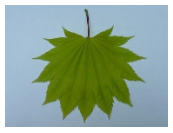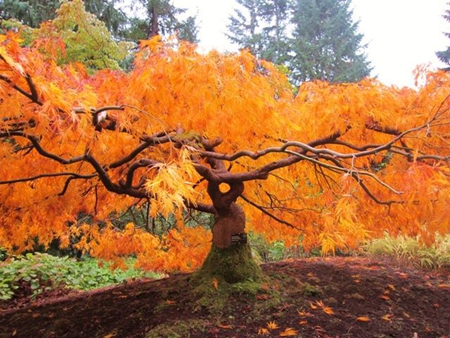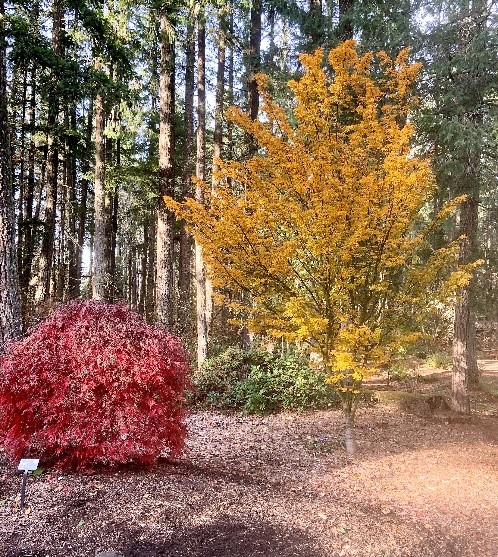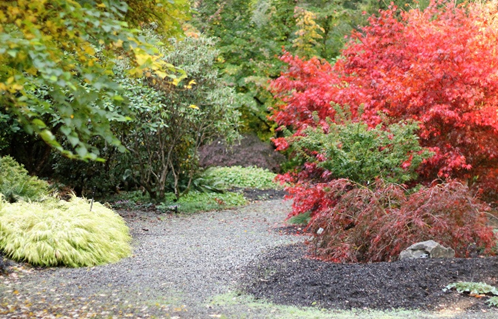Many people will tell you that Japanese maples are the most desirable garden trees that exist. This must have something to do with the grace and beauty the trees add to the garden through all four seasons. Native to Japan, Korea, China, eastern Mongolia and southeast Russia, Acer palmatum has been cultivated in Japan for centuries and in temperate areas around the world since the 1800s. While Acer palmatum cultivars are what is most often referred to as Japanese maple, some may include maple trees from species Acer japonicum and Acer shirasawanum, both of which are native to Japan. The Lake Wilderness Arboretum’s collection of Japanese maples includes cultivars from all three species.
Japanese maples differ from one another in leaf form, leaf color, overall shape and size. Typical of maples, Japanese maples have lobed leaves with veins spreading out like the fingers of a hand but they are smaller than on a typical maple tree. Acer palmatum leaves have five, seven or nine pointed lobes while Acer japonicum and A. shirasawanum have 9 – 13 lobes. See the photos below for examples.


The leaf color of Japanese maples is usually green or red but the variety within those two colors is wide. Some trees will have remarkable color on their new spring leaves, perhaps fading to another color for summer and then bursting forth with dramatic color in the fall, like Acer palmatum ‘Okushimo’ which starts with chartreuse leaves in the spring, fading to darker green in summer and turning bright yellow to orange in fall. Some, like Acer palmatum ‘Moonfire’ and A.p. ‘Bloodgood’, will hold their red coloring all summer while others may be variegated with white, green, pink or red, such as A. p. ‘Orido Nishiki’ which blends bright pink, cream and green throughout each leaf. There are even some where the color extends to the bark (A.p. ‘Bihou’, A.p. ‘Sango-Kaku’) which makes quite a show in the winter.
Some Japanese maples can grow up to 20 feet or more in height, while others remain as low shrubs only reaching five feet after many years of growth, such as Acer palmatum ‘Caperci Dwarf’. Some are upright in form, or pendulous and cascading like our Anniversary maple, Acer palmatum dissectum ‘Viridis’. This tree was 25 years old when it was planted at the Lake Wilderness Arboretum while the Arboretum was celebrating its 25th Anniversary. That makes the tree 50 years old now.
How did we end up with so many different cultivars of Japanese maple? These trees are naturally very variable and Japanese gardeners began to collect different forms and produce more from seedlings so that today at least a thousand different forms are known. Many forms were developed in Japan and these have Japanese names, while others were bred in Europe or America and usually have English-sounding names.
Japanese maples are great for the garden because they have few pest or disease problems and are versatile enough to thrive in locations ranging from full shade to full sun. They can be grown in the garden where they are ideal growing under mature, large trees or in containers on decks or small patios. A tree in fall is guaranteed to turn heads and gather admiring looks and the enormous variety of leaf forms, colors and tree shapes means that no matter what your taste or space restrictions, there will be a tree for you. The Lake Wilderness Arboretum nursery often has a variety of Japanese maples available for sale, so come check them out during one of the Arboretum’s plant sales.
How to select a maple:
- Choose a variety that is rated to be cold hardy in your zone (we are in USDA zone 8b or Sunset Western Garden Collection zone 4). If planting in a pot or container above ground, choose a variety that is at least two cold zones hardier than our zone.
- Determine how large you can allow your tree to grow.
- Where will it be planted, sun or shade? Most prefer morning sun and afternoon shade
- Choose type: weeping vs. upright
- Choose leaf color preference: red, green or variegated

The “Anniversary” Japanese Maple in the arboretum 

